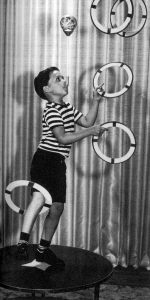|
Practicing hurdle joggling with Kris Akabusi, bronze medalist in the 400 meter hurdles in the 1988 Olympics. |
Page 21 Summer 1996
|
Juggling Legends Lead Lucas to be his own Champion
The
world of show business around him has changed drastically since
four-year old
Albert Lucas appeared on stage holding a ball in one hand, spinning
hoops on an arm and leg, and juggling two rings with the other hand.
Now
Lucas is 36. Ice Capades is bankrupt and Ed Sullivan has gone on to
his reward. The demand for classical "flash" juggling acts
like Lucas's has waned as the public's appetite for comedy jugglers
and team acts has increased. Very few big production shows in Las
Vegas have live orchestras any more, and the demise of the Soviet
Union has released an influx of Eastern bloc performers to compete
for the remaining spots in the industry. The increased talent pool
has also forced salaries down.
But
instead of resisting the trend away from his training, Lucas has met
the challenges of a changing entertainment environment and
maintained his status as one of the art's foremost champions. The
IJA honored his accomplishments with its Award of Excellence at the
summer festival in Rapid City.
Three
factors weighed heavily in his success - an early start, good
coaching from his father, Albert Moreira, and interminable practice.
His standard seven-minute stage routine includes 2,500
tosses, and usually no drops. That kind of discipline is
expected of those born to show business, and was carefully nurtured
from an early age by Moreira, who was himself a show business
veteran.
Moreira
was a founding member of Los Gattos (Nick Gatto was also a member),
and this famous acrobatic act toured the world for many years. From
Royal Command performances to Vegas night clubs, major
Albert
began juggling at age three and was on stage at four. From the
beginning he listened eagerly to his father's stories about great
jugglers like Rastelli, Serge Flash, Jenny Jaeger, Ernest Montego,
Bobby May, Trixie and Francis Brunn, and was inspired by their
achievements. He was curious to know everything about them - how
many rotations did Rastelli throw? Why didn't Serge Flash have a
knob on the end of his stick? As he grew and came to better
understand his father's career and the grandeur of juggling in the
previous generation, he became resolved to keep the legacy alive.
He
practiced up to six hours a day in those early years and performed
with many of the small tent circuses touring the US during the
Lucas's
association with the IJA began with his first convention in 1969,
where his skills were greatly admired. But the impression was
overwhelming the next year, when 10-year-old Lucas won the numbers
championship in Los Angeles by juggling seven rings for 61 seconds!
In
1971 he signed his first Las Vegas contract, and became the youngest
performer ever to appear with the Folies Bergere at the Tropicana
Hotel. He was so beloved by Vegas audiences that
"Fabulous" magazine crowned him as Variety Act of the
Year.
During
that time, a representative of Ice Capades invited Lucas to join
that globetrotting troupe, if he could translate his act to ice!
He accepted the challenge to try, and spent many eight hour days
practicing the skill
At
age 16 backstage after a show Lucas flashed 10 rings for his father,
who promptly asked him to do it again. Shortly thereafter he was
doing eight and nine in his act. His greatest technical on-ice
achievement was balancing on one ice skate, spinning two hoops on
his right leg, balancing a ball on a mouth stick and juggling nine
rings for the cycle.
He
left Ice Capades in 1982 to settle on the smaller rink at the
Hacienda Hotel in Las Vegas. He had performed in Vegas as an opening
act several times during his eightweeks off between Ice Capades
tours, but the "Fire & Ice" show at the Hacienda was
his first full-time night club ice show.
He
was doing tricks on ice that few jugglers could do on solid ground.
It began with 30 seconds of seven rings. It continued with four
tennis rackets with tosses over the shoulder, four split, two high
with a pirouette, five rackets with a toss under the leg, four
scarves, and a comedy routine with three ping pong balls. He
followed that with three clubs, then seven balls tossed into a
billiard pocket belt. The final catch involved a quadruple
pirouette. His penultimate routine was the selfdescribed
"garbage trick," spinning a beach ball on a mouth piece,
hoop spinning on the right arm, ball spinning on a finger, three
hoops juggled with the left hand and a hoop spinning on the left
leg. He concluded the act with |
|
Practicing hurdle joggling with Kris Akabusi, bronze medalist in the 400 meter hurdles in the 1988 Olympics. |

Albert shows an early version of the "garbage" trick at age five. |

The combination trick became more complex as Lucas grew up. |
Spinning a hoop on a leg, balancing and flashing nine at age 18. |